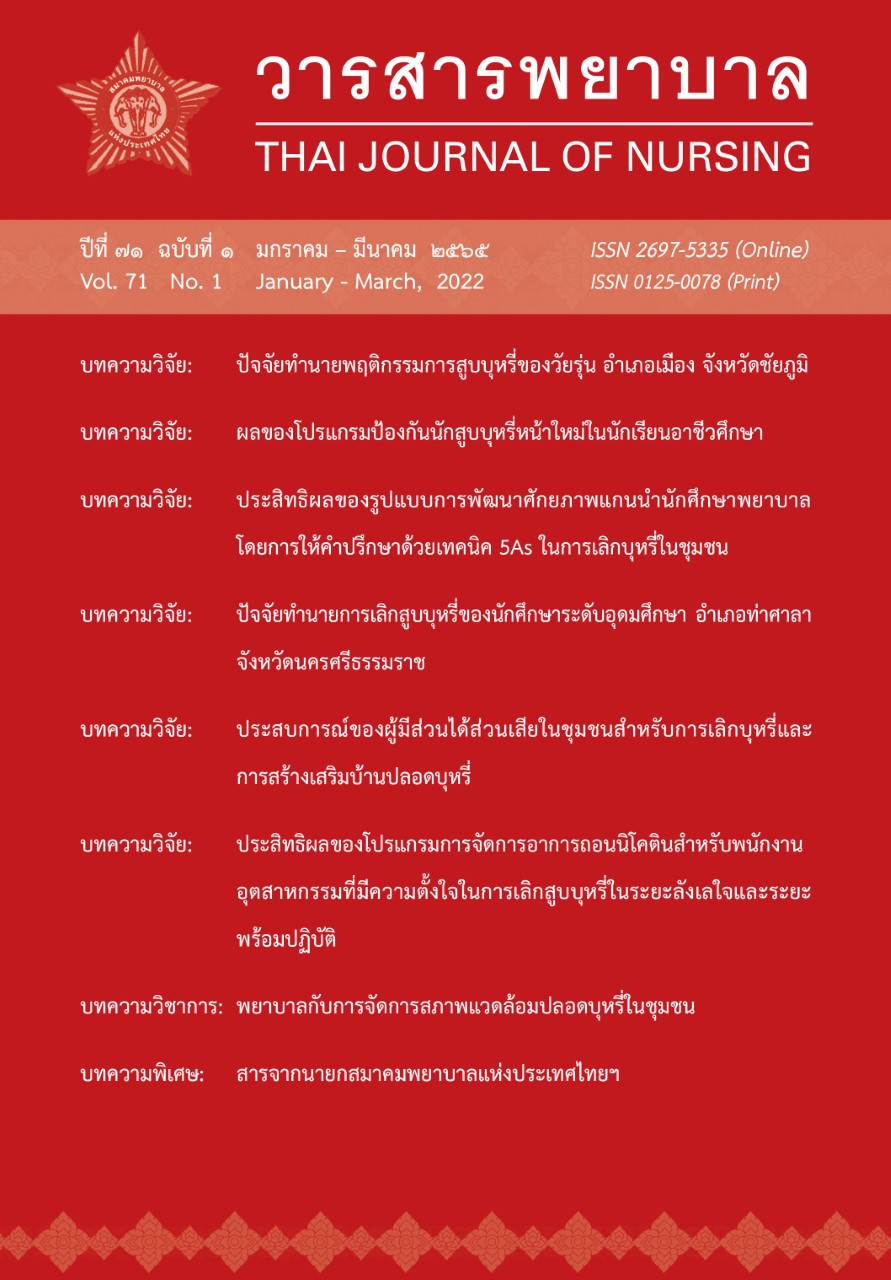Factors predicting smoking cessation among higher education students at Tha Sala District in Nakhon Si Thammarat Province
Main Article Content
Abstract
This cross- sectional design aimed to examine the predicting factors of smoking cessation of higher education students at Tha Sala District in Nakhon Si Thammarat Province. A sample of 198 first-year male students, was purposively selected. Data collected during September to November 2563 BE by using self-administered questionnaire including general information, perception on quitting smoking, opinion toward the policy on smoking cessation in higher education institutions, and perception on the Tobacco Products Control Act, B.E. 2560. Descriptive statistics and Binary logistic regression analysis were employed for data analysis. The results indicated that students’ smoking behaviors were ever smoking (57.56%), currently quit smoking (44.95%), quit smoking more than six months (18.69%). The information smoking cessation from public health personnel was obtained 45.61%, and from university campaign 14.00%. Quit smoking immediately 64.04% were used. The predicting factors of smoking cessation were sufficient income, quit smoking decision, and smoking replacement at p < .05.
Article Details

This work is licensed under a Creative Commons Attribution-NonCommercial-NoDerivatives 4.0 International License.
References
กระทรวงสาธารณสุข กรมควบคุมโรค. (2562). พระราชบัญญัติควบคุมผลิตภัณฑ์ยาสูบ พ.ศ. 2560. สืบค้นเมื่อ 7 มีนาคม
, จาก https://ddc.moph.go.th/law.php?law=2
นัยนา หนูนิล, สายฝน เอกวรางกูร, และเรวดี เพชรศิราสัณห์. (2556). การนำมติสมัชชาสุขภาพแห่งชาติการ
ควบคุมยาสูบสู่การปฏิบัติในจังหวัดภาคใต้ตอนบน: กรณีศึกษาจังหวัดตรังและชุมพร. รายงานการ
วิจัยของมหาวิทยาลัยวลัยลักษณ์, นครศรีธรรมราช.
นัยนา หนูนิล, สายฝน เอกวรางกูร, เรวดี เพชรศิราสัณห์, ธนวรรณ สงประเสริฐ, ลักษมล ลักษณะวิมล, พิกุล
ทิพย์ ขุนเศรษฐ, และสิทธิพรรณ เรือนจันทร์ (2563). การเปรียบเทียบสถานการณ์การบริโภคและการ
ควบคุมยาสูบของโรงเรียนในพื้นที่ผลิตยาเส้นและพื้นที่ทั่วไป จังหวัดนครศรีธรรมราช. รายงานการ
วิจัยของมหาวิทยาลัยวลัยลักษณ์, นครศรีธรรมราช.
ปราณี เทียมใจ, และปรัชญาพร ธิสาระ. (2555). การพัฒนามหาวิทยาลัยปลอดบุหรี่ต้นแบบโดยคณะพยาบาล
ศาสตร์ มหาวิทยาลัยพะเยา. วารสารพยาบาล, 61(1), 1-9.
พรรณี ปานเทวัญ, และอายุพร ประสิทธิเวชชากูร. (2557) การประยุกต์ทฤษฎีขั้นตอนการเปลี่ยนแปลง
พฤติกรรมกับการปรับเปลี่ยนพฤติกรรมการสูบบุหรี่ วารสารพยาบาลทหารบก, 15 (1), 36-44.
มหาวิทยาลัยมหิดล ศูนย์วิจัยและจัดการความรู้เพื่อการควบคุมยาสูบ (ศจย.). (2563). รายงานสถานการณ์การ
บริโภคยาสูบของประเทศไทย พ.ศ. 2562 (พิมพ์ครั้งที่ 1). กรุงเทพมหานคร: สินทวีกิจ พริ้นติ้ง.
ลัคนา เหลืองจามีกร, วิกุล วิสาลเสสถ์, ธงชัย วชิรโรจน์ไพศาล, และสุรัตน์ มงคลชัยอรัญญา. (2549). การสำรวจ
เพื่อเฝ้าระวังการบริโภคยาสูบของนักศึกษาวิชาชีพสุขภาพในประเทศไทย พ.ศ. 2549: นักศึกษาทันตแพทย์
ภาควิชาทันตกรรมชุมชน คณะทันตแพทยศาสตร์. กรุงเทพมหานคร: จุฬาลงกรณ์มหาวิทยาลัย.
วิชัย เอกพลากร. (บ.ก.). (2564). รายงานการสำรวจสุขภาพประชาชนไทยโดยการตรวจร่างกาย ครั้งที่ 6 พ.ศ.
-2563 (พิมพ์ครั้งที่ 1). กรุงเทพมหานคร: อักษรกราฟฟิคแอนด์ดีไซน์.
ศศิธร ชิดนายี, และวราภรณ์ ยศทวี. (2561). ปัจจัยที่มีความสัมพันธ์กับพฤติกรรมการสูบบุหรี่ของวัยรุ่น
จังหวัดอุตรดิตถ์. วารสารวิทยาลัยพยาบาลบรมราชชนนี อุตรดิตถ์, 10(1), 83-93.
สมภพ เรืองตระกูล. (2551). ตำราจิตเวชเด็กและวัยรุ่น (พิมพ์ครั้งที่ 2). กรุงเทพมหานคร: เรือนแก้ว.
สุปราณี อัทธเสรี. (2552). การพัฒนามหาวิทยาลัยแม่ฟ้าหลวงเป็นมหาวิทยาลัยปลอดบุหรี่ต้นแบบ. วารสาร
พยาบาล, 58(3-4), 1-14.
Bursac, Z., Gauss, C. H., Williams, D. K., & Hosmer, D. W. (2008). Purposeful selection of variables in
logistic regression. Source Code Biology and Medicine, 3, 17. Retrieved January 15, 2021, from
https://doi.org/10.1186/1751-0473-3-17
Faul, F., Ider, E. E., Lang, A. G., & Buchner, A. (2007). G*Power 3: A flexible statistical power analysis
program for the social, behavioral, and biomedical sciences. Behavioral Research Methods, 39(2),
-191.
Gilman, S. E., Abrams, D. B., & Buka, S. L. (2003). Socioeconomic status over the life course and stages
of cigarette use: initiation, regular use, and cessation. Journal of Epidemiology and Community
Health, 57, 802-808.
Prochaska, J. O., & DiClemente, C. C. (1983). Stages and processes of self-change of smoking: Toward
an integrative model of change. Journal of Consulting and Clinical Psychology, 56(4), 520-528.
Prochaska, J. O., & Velicer, W. F. (1997). The transtheoretical model of health behavior change.
American Journal of Health Promotion, 5(1), 38-48.
Riley, T., & Paek., K. (2010). Factors associated with the smoking cessation behavior according to the
Transtheoretical Model in Korean college students. Korean Journal of Health Education and
Promotion, 27(5), 27-39.
Siriwong. S. (2015). Exploring quitting smoking behavior among Royal Thai Navy personnel with the
transtheoretical model. Procedia-Social and Behavioral Sciences, 191, 1062–1068.
Sutfin, E. L., McCoy, T. P., Berg, C. J., Helme, D. W., O'Brien, M. C., & Wolfson, M. (2012). Tobacco
use by college students: a comparison of daily and nondaily smokers. American Journal of Health
Behavior, 36(2), 218-229.
Velicer, W. F., DiClemente, C. C., Rossi, J. S., & Prochaska, J. O. (1990). Relapse situations and self-
efficacy: An integrative model. Addictive Behaviors, 15, 271-283.
World Health Organization. (2017). WHO global report on trends in tobacco smoking 2000-2025.
Retrieved December 19, 2020, from https://www.who.int/publications/i/item/who global report-on
trends in Prevalence of tobacco-use


